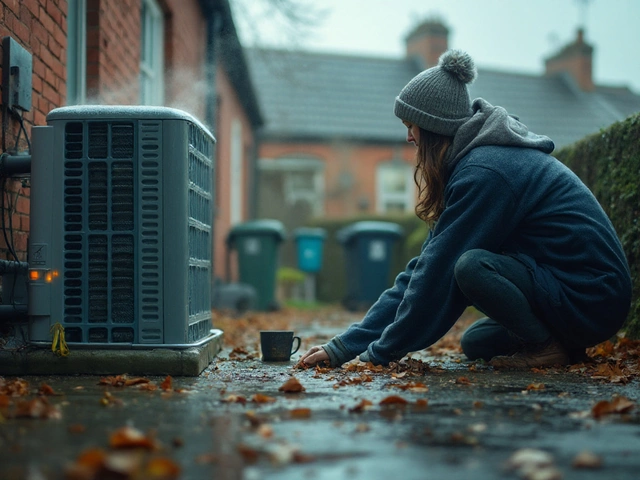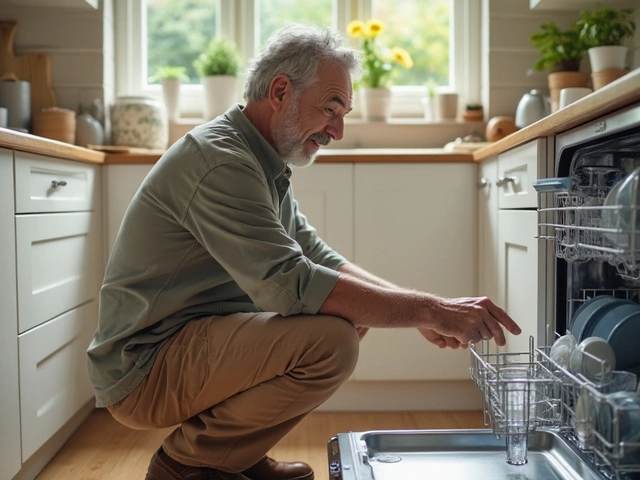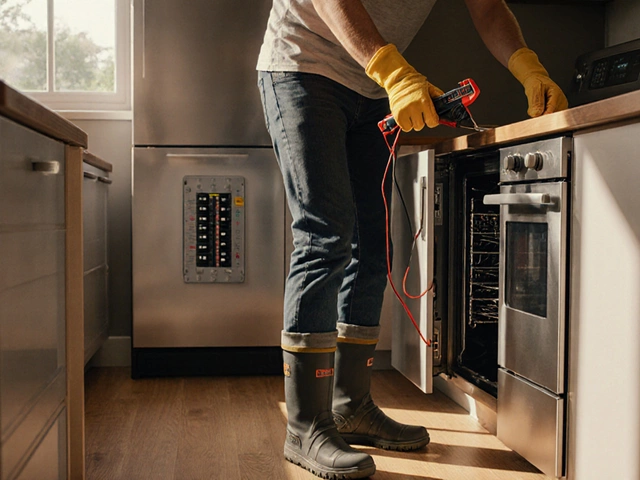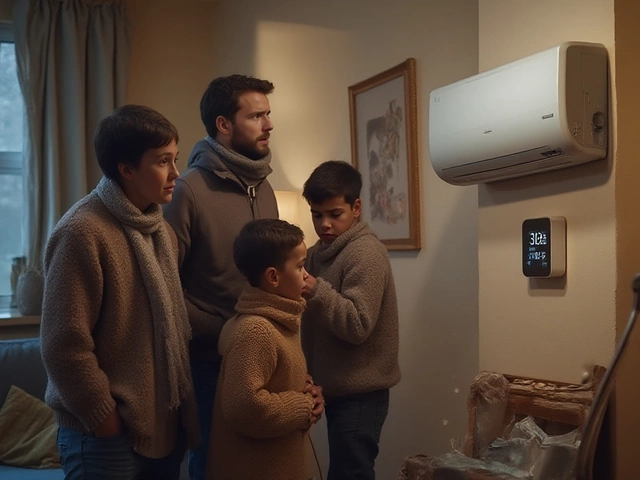If you’re staring at a 15‑year‑old oven that just quit mid‑roast, here’s the straight answer: you should only repair 15 year old oven units when the fault is minor, parts are easy to source, and the repair is cheap compared to a decent replacement. I’ll show you how to know that in minutes-using real costs in Australia (I’m in Adelaide), simple rules of thumb, and a quick calculator you can run on the back of an envelope. Expect clear price bands, safety flags, and what to try before you book a tech.
- Rule of thumb: if the repair quote is under 35-40% of a like‑for‑like replacement (installed), and the oven has no other issues, repair. Otherwise, replace.
- Typical repair ranges in Australia (2025): call‑out $120-$180; elements $80-$200; thermostats $150-$250; control boards $300-$600; labour $100-$150/hr.
- A good new 60 cm electric built‑in is $700-$1,500; install $250-$600. Expect 10-15 years of life. CHOICE puts ovens around the 10-15 year mark.
- Energy savings from a new oven are modest for most households (often $30-$90/year), but reliability, temperature accuracy, and safety jump up.
- Red flags: burnt wiring smell, tripping safety switch, cracked element exposing live parts, repeated board failures-don’t throw money at those on a 15‑year‑old unit.
Make the call in 5 minutes: a simple decision rule (with quick maths)
At 15 years, your oven is at the far end of its expected life. CHOICE’s longevity guides and manufacturer data place most ovens in the 10-15 year range. That doesn’t mean yours must go today-it means repair has to be the right kind of repair.
Use this order:
- Identify the fault type
- Minor: door seal, light, knob, fan motor bearings, grill/element swap, temperature sensor.
- Major: control board, full wiring harness, cavity insulation damage, repeated thermostat failures.
- Safety issues: burning smell from wiring, RCD/safety switch trips, visible arcing. Stop using and get a licensed tech.
- Get a real‑world price
- Call‑out in cities like Adelaide/Sydney/Melbourne is often $120-$180.
- Parts + labour typical: $180-$450 for minor faults; $400-$900 for boards/complex issues.
- Compare to replacement (installed)
- Like‑for‑like new mid‑range 60 cm built‑in: $700-$1,500.
- Installation (electrician): $250-$600. Gas connection by a licensed gasfitter is similar.
- Cabinet trim/filler pieces if sizes changed: $100-$300.
- Apply the 40% rule
- If the repair quote < 40% of new + install, and no safety red flags, repair can make sense.
- Above 40% on a 15‑year‑old oven, you’re likely chasing diminishing returns.
- Adjust for your usage and plans
- Heavy baker? Temperature accuracy and evenness matter-modern ovens are better here.
- Moving soon or selling? A fresh oven helps resale and avoids inspection fail drama.
- Keeping the home 5+ years? Reliability + warranty on new gear often wins.
Quick calculator you can do in 60 seconds:
- Repair path: Repair Quote + (Expected Future Repairs over 3 years) + (Safety risk, price this at $0 if none, otherwise treat as a push toward replacement)
- Replace path: New Oven Price + Install + (Cabinet trim if needed) − (Energy savings over 3 years, often modest)
If Repair path < 40% of Replace path and no safety flags or part scarcity, go ahead. If it’s close, lean replacement when your oven has had two or more significant faults in the past two years.
Real Australian costs (2025): repairs vs a new oven, and what each buys you
I’ll keep it blunt: what you pay should buy you meaningful life extension or better performance. Here’s what that looks like in dollars and years.
| Item | Typical Cost (AUD) | What You Get | Notes (Australia, 2025) |
|---|---|---|---|
| Call‑out / diagnosis | $120-$180 | Tech visit, initial fault finding | Often credited if you proceed with repair |
| Heating element (bake/grill) | $80-$200 part; $100-$200 labour | Restores heat; +2-5 years if rest is sound | Common and fair value on older ovens |
| Door seal (gasket) | $30-$70 part; $80-$150 labour | Improves heat retention & temps | DIY‑able on many models |
| Fan motor | $120-$250 part; $150-$250 labour | Fixes uneven cooking, noise | Value depends on oven condition |
| Thermostat / temp sensor | $150-$250 part; $120-$200 labour | Restores temperature accuracy | Good repair if panel is healthy |
| Control board (PCB) | $300-$600 part; $150-$250 labour | Brings dead/electronic faults back | On a 15‑year unit, often not worth it |
| Wiring repair | $150-$450 | Stops tripping, arcing | Red flag if insulation is baked/brittle |
| New 60 cm electric oven | $700-$1,500 | 10-15 years, better temp control | 2‑year warranty common; some brands 3-5 |
| Installation (electrician) | $250-$600 | Safe fit, compliance | Hard‑wired 15A circuits are common |
| Cabinet trim/filler | $100-$300 | Neat fit if sizes differ | Most 60 cm units are standard; check cutout |
Price sources: Adelaide/Melbourne/Sydney quotes and invoices I’ve seen over the past year, plus ranges reported by techs and retailers. Labour bands line up with what you’ll hear from local electricians and appliance techs. For consumer context, CHOICE’s reviews and buying guides back the 10-15 year lifespan and mid‑range pricing bands. Warranty norms come from Australian retailer listings in 2024-2025.
How long will a repair buy you on a 15‑year‑old unit? Minor parts can safely add 1-3 years. Major electronic parts might still die early because heat and time age everything else around them. That’s why a $500 board on a 15‑year oven often feels like throwing good money after bad-unless the oven is premium and immaculate.
Gas ovens: parts (thermocouples, igniters) are usually cheap, but if you smell gas or the flame sensor is unreliable, you need a licensed gasfitter. Many Australian homes are moving away from gas in kitchens; if your gas oven is 15 years old and misbehaving, the install cost to switch to electric can be worthwhile long term, especially in SA where the grid has high renewable penetration.
Energy, safety, and performance: what changes when you upgrade
Energy savings aren’t the whole story, but they do add up. Typical electric ovens draw 2-3 kW while heating, then cycle. In CHOICE lab tests, a standard roast session can use roughly 1.5-2.5 kWh, depending on size, insulation, and fan usage. Older ovens tend to leak more heat and run less efficiently, but the gap to a modern unit isn’t like fridges or heat pumps-think 10-25% for many households, not 50%.
South Australian power prices in 2025 on variable residential tariffs often sit around 35-45c/kWh with GST, based on AER default market offer data and retailer plans. Using 40c/kWh as a simple average:
- Light usage (1 roast/week, 2 kWh per session): ~104 kWh/year ≈ $42/year
- Medium (3 cooks/week, mix of baking/roasts, 2 kWh avg): ~312 kWh/year ≈ $125/year
- Heavy (5 cooks/week, 2.5 kWh avg): ~650 kWh/year ≈ $260/year
If a modern oven saves 15% versus your old one, that’s roughly $6-$40/year, depending on how you cook. If you run a lot of long bakes and use fan‑forced cleverly, savings creep higher, but ovens are not the biggest energy hog. The bigger wins from replacing are:
- Temperature accuracy and evenness: Modern thermostats and fan systems are better. Your bakes hit the target temps more often, which matters for bread, pastry, and roasts.
- Safety: Newer insulation, door glass, and child locks reduce burn risk. If your old oven runs hot on the fascia or trips the RCD, that’s a serious sign to replace.
- Reliability and parts: After 15 years, plastics, connectors, and insulation are tired. Even if you fix one part, another can fail soon. New ovens come with 2+ years of warranty baked in.
- Cleaning: Pyrolytic cycles are convenient but energy‑hungry (3-6 kWh a cycle in lab tests). Catalytic liners are a nice middle ground with less energy hit.
Gas vs electric: If you’re on reticulated gas, running costs depend on your retailer tariff (often priced per MJ). Electric ovens pair well with rooftop solar; cooking during the day can bring your marginal cost near zero. Many South Australians now size appliance choices around their solar generation-worth factoring in.
Safety note: If you ever smell burning wiring, see arcing, or the safety switch trips when the oven heats, stop using it and call a licensed electrician or appliance tech. No recipe is worth a fire. Australian Standards require licensed trades for electrical/gas work; Master Electricians Australia and state regulators put this front and centre for a reason.
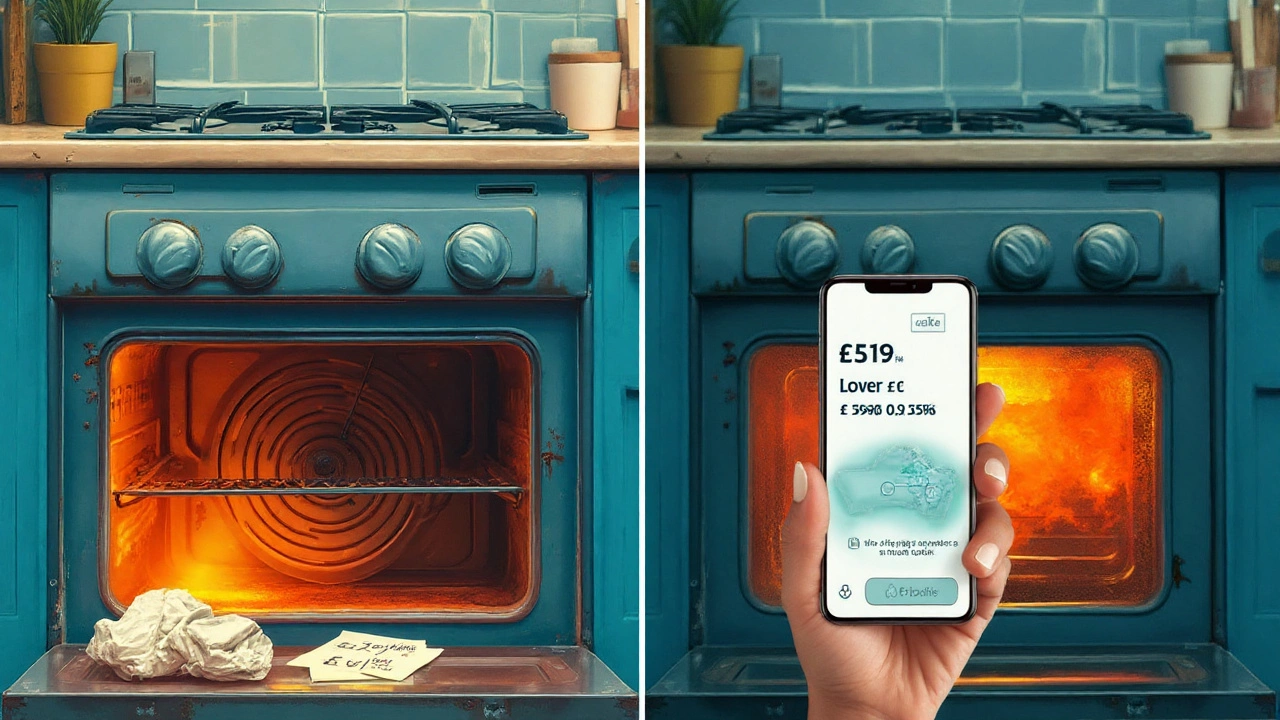
DIY checks before you spend a cent (and what not to touch)
A few safe checks can save you a pointless call‑out. If you’re not comfortable, skip these and call a pro, but here’s what most homeowners can do safely.
- Power and breaker
- Is the switch on? Has the circuit breaker or RCD tripped? Reset once. If it trips again on heat, stop and call a tech.
- For plug‑in benchtop ovens only: try a different outlet to rule out a dodgy socket. Built‑ins are usually hard‑wired-don’t pull them out yourself.
- Door seal and hinges
- Run your hand around the closed door edge (careful if hot). If you feel strong heat or see splits in the gasket, a new seal is cheap and effective.
- If the door sags or doesn’t close tight, hinges or hinge receivers may be worn.
- Element and fan behavior
- Turn on bake/grill and look through the door. Does the element glow evenly? Cold patches suggest a failed section.
- Fan‑forced mode: does the fan spin smoothly? Loud scraping or no spin points to a failing motor or a loose shield.
- Temperature sanity check
- Use an oven thermometer. Set 180°C and wait 20 minutes. If you’re 15-25°C off, a sensor or thermostat may be out.
- Uneven bakes shelf‑to‑shelf often mean a fan issue or poor door seal.
- Clean the basics
- Remove carbon buildup from around the fan cover and elements (when cool). Crud can burn, smell, and throw heat off.
- Don’t spray cleaners into control knobs or behind panels.
What not to DIY:
- Replacing hard‑wired elements, thermostats, boards, or touching internal wiring. In Australia, this is licensed work.
- Pulling a built‑in oven out of cabinetry if it’s heavy, hard‑wired, or sealed. You can damage the wiring, bench, or yourself.
- Gas anything (igniters, valves, connections). Leave it to a licensed gasfitter.
Parts availability check: Before you spend on diagnosis, Google your brand + model + “spare parts Australia”. If elements or boards are marked discontinued, that’s a sign to replace-techs can sometimes find compatible parts, but it gets pricey and slow.
Your game plan: scenarios, checklists, and trade‑offs (with Adelaide/AU context)
Use these common scenarios to decide fast.
- Only the bake element is dead; oven is tidy; you’re happy with it: Repair. Expect $220-$380 all‑up. You’ll likely get a few more good years.
- Control panel is blank or glitchy; oven is 15 years old: Replace. A board at $450-$800 installed on a tired unit is rarely smart.
- Door won’t seal; temps are all over the shop; hinges sag: If you love the oven and parts are cheap, a seal + hinge job can work. If combined quote hits $400+, price a new unit.
- RCD trips when heating: Safety first. Get a licensed electrician or appliance tech. On a 15‑year‑old unit, replacement is often the safer end state after diagnosis.
- Renting out the property: Reliability beats nostalgia. A fresh, simple oven with a 2-3 year warranty reduces tenant call‑outs and urgent repairs.
- You’ve got solar and cook in daylight: Replacement tilts slightly more attractive. You’ll capture more of your own generation with a reliable, accurate oven.
Replacement checklist (save this):
- Measure the cavity (W×H×D). Most built‑ins are 60 cm wide, but heights and depths vary.
- Note the circuit: 10A vs 15A. Many modern ovens prefer a 15A dedicated circuit. An electrician can confirm.
- Decide on functions you actually use: fan‑forced, grill, timer, steam assist, pyrolytic cleaning. Don’t overpay for fluff.
- Shortlist brands with local parts and service. Ask a retailer about parts lead times in Australia.
- Plan installation and disposal. Electrician: $250-$600. Recycling options depend on your council and retailer take‑back.
- Warranty: 2 years standard; some offer 3-5. Keep receipts and register.
Repair checklist:
- Ask for a ballpark before the visit: what’s your call‑out, and typical cost for [my symptom]?
- Confirm part availability and warranty on parts/labour.
- Set a ceiling: “Don’t proceed if it will exceed $X without calling me.”
- Request the old part back if you want proof of failure.
- Check the oven’s cavity and wiring condition while they’re there. If it’s heat‑stressed, re‑think further repairs.
Adelaide note: SA labour rates sit around the national average to slightly higher on licensed electrical work. Same goes for electricity prices. If you’re in the suburbs, you’ll find plenty of mobile techs; for regional SA, travel charges can add $50-$120.
Next steps, mini‑FAQ, and troubleshooting paths
Here’s how I’d proceed from here:
- Do the safe DIY checks above. If a $30-$70 door seal or an obviously blown element is the problem, that’s promising.
- Call one local appliance tech and one electrician for rough numbers (describe the fault and model). Don’t authorise until you hear the range.
- Price a like‑for‑like new oven and install. Keep a simple comparison sheet with total all‑in costs.
- Apply the 40% rule. If it’s close, lean replacement if the oven has multiple age‑related issues or any safety concerns.
Mini‑FAQ:
- How long do ovens last? CHOICE and brand data put most at 10-15 years. Premium units can go longer if well maintained, but electronics are the limiting factor.
- Is it worth replacing just the element? Yes, often. It’s cheap, common, and buys 2-5 years if everything else is in good nick.
- Will a new oven cut my power bill a lot? Usually not a lot. Savings are real but modest for typical households. The win is consistency, safety, and warranty.
- Should I switch from gas to electric? If you’re already considering replacement, it’s worth pricing. Electric pairs well with solar and future‑proofs the kitchen. Factor in electrician costs for a dedicated circuit.
- What about a used oven? Risky, unless you know the history. No warranty, unknown abuse, and removal/fit costs can eat “savings”.
- Can I claim repairs on tax for a rental? Repairs to restore function are typically deductible; upgrades are usually depreciated. Ask your tax advisor for your case.
Troubleshooting by symptom:
- No heat at all; light and fan work: Likely element or thermostat. Good repair candidate if parts available.
- Trips RCD when heating: Moisture or insulation fault, sometimes a failing element. Needs a licensed tech. On a 15‑year unit, weigh replacement.
- Uneven baking: Check fan, door seal, and shelf positions. A new fan or seal can fix it cheaply.
- Temperature too low/high vs setting: Calibrate if your model allows; otherwise sensor/thermostat. If the control board is flaky, consider replacing the oven.
- Door won’t close tight: Hinges/seal. Nice, contained repair-good value if the rest is healthy.
Risks to avoid:
- Spending $500-$700 on a board when wiring and plastics are already heat‑stressed. That new board lives in a tired body.
- DIYing hard‑wired electrics or gas. Australian law requires licensed trades for a reason.
- Forgetting install costs in your comparison. A “$799 oven” is not $799 once fitted.
One last nudge on timing: If your oven is limping into summer and you barely bake until winter, you could try a minimal repair or limp‑along fix (like a door seal) and plan a full replacement during an end‑of‑financial‑year sale. Retailers in Australia discount hard in May-July, and installers have slots.
Bottom line: A cheap, contained fix on a 15‑year‑old oven is fine. Anything major? Put that money toward a reliable, warrantied replacement and enjoy the upgrade-your roasts, and your future self, will thank you.



